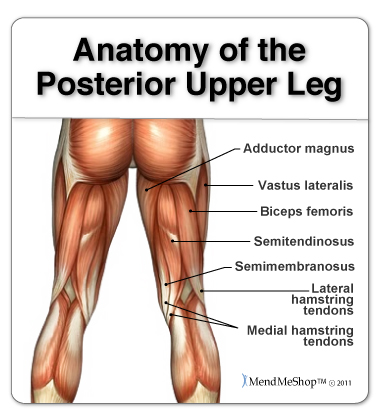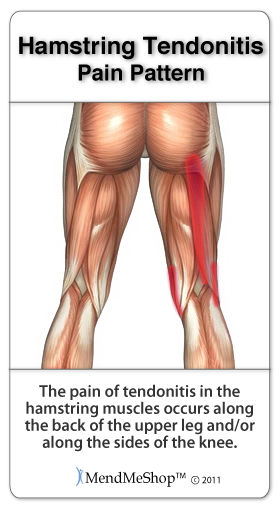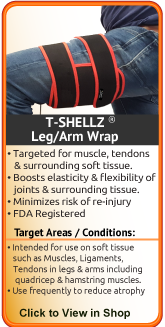What is Hamstring Tendonitis?
The hamstrings refer to 3 long posterior leg muscles, the biceps femoris, semitendinosus, and semimembranosus. These muscles start at the bottom of your pelvis extending down the back of your thigh and along either side of your knee, to your lower leg bones.
The lateral hamstring is the biceps femoris (made up of 2 parts - a short head and long head) and the medial hamstrings are the semitendinosus (joins the sartorius muscle and gracilis muscle at the pes anserinus on the tibia) and the semimembranosus (the largest hamstring muscle). The tendons for these muscles begin at your ischial tuberosity, or ischium (the bony bump under each buttock), and attach on the outer edges of your shinbones (tibia and fibula) just below the back of your knee.
The posterior upper leg muscles provide your knees with mobility (extension, flexion and rotation) and strength. They work closely with your quadriceps muscles at the front of your thigh, your gluteal muscles, and your calf muscles to ensure proper movement of your leg and hip.
Your hamstring muscles control movement of your torso, hips and knees, help turn your legs in and out. They also provided power for activities that include a lot of propulsion, thrust and control, such as jumping, climbing, and running.
They allow your knee to bend and pull your leg backward while propelling your body forward when you move (your thigh straightens and extends the leg back at the hip). The muscles act as a brake to stop an action and you can feel this when walking or running downhill, landing from jumps or performing squats, and when trying to stop quickly after sprinting.
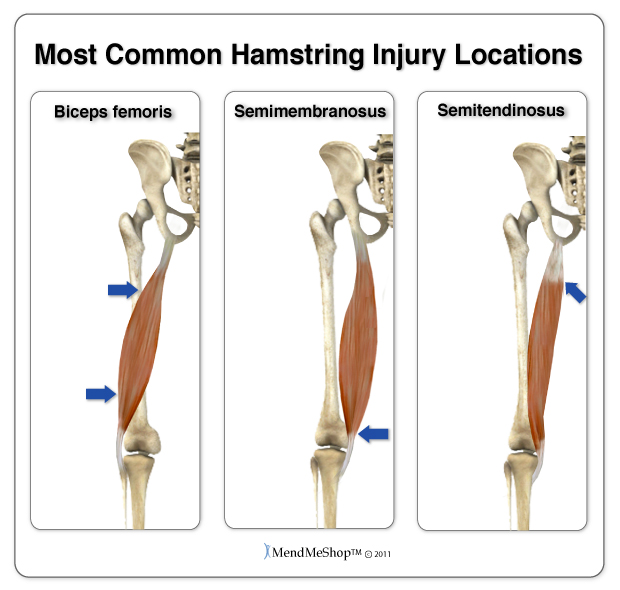
The biceps femoris hamstring muscle is the most frequently injured, as it suffers the largest stretch during sprinting, followed by the semitendinosus muscle. If you have a multi-muscle injury, it normally occurs at the point where your hamstring muscles and tendons meet (musculotendinous junction) at the top of the hamstring muscles.
Symptoms of Hamstring Tendinitis
Hamstring pain when your dealing with hamstring tendinitis causes an aching and stiffness which become more noticable first thing in the morning. You may feel weak in the knee and swelling in the thigh and calf muscles. You may fell a graduall pain in the back of the knee when continues to get worse with activity. Hamstring tightness can lead to knee pain, hip pain, thigh pain, and even back pain.
Causes of Hamstring Tendinitis
The most common cause of hamstring tendonitis is through overuse of the hamstring muscles. Sports that involve a lot of running and jumping or rapid changing of speed while running. Normally an injury as a result of overuse, hamstring tendonitis can also occur suddenly if the tendon becomes over stretched, such as when warm-up exercises or have been missed with a cold down after working out. As well over doing it with a workout or training to much-too-soon, causing the over-strain the hamstring when running, kicking, jumping or skipping movements.
The hamstrings are not regularly used in common everyday motions like walking and standing. For people who are not very active, you may not notice if they have weak hamstring muscles, which leads to hamstring injuries.
How do I Diagnose Hamstring Tendinitis?
A visit to your doctor is the best way for diagnosis of any type of hamstring / leg pain. To help your doctor achieve a proper diagnosis, he/she will begin with a medical history about you, your current condition and symptoms. He/she will inquire about the intensity of your present pain, the duration of your symptoms and the limitations you are experiencing. Details about what instigated the problem, when it started, and whether or not you have ever had treatments for this or a similar condition in the past, are very helpful in assessing your injury.
Diagnostic testing may be ordered help discover your source of leg pain. Often used to rule out other conditions. MRIs (magnetic resonance imaging) will provide more detailed information and will help to evaluate the soft tissues in and around your area of pain (muscles, tendons, ligaments, and other connective tissues). It can identify ligament or tendon damage, and can help to determine the extent of your injury, the displacement and degree of your tear or inflammation, as well as other associated hamstring conditions.
We have tools that will help you to prevent and treat the symptoms of hamstring tendinitis. When it comes to your injured hamstring, it's best to start effective long term healing right away. Our Advisers are highly trained individuals and will help find the long term healing goal that's right for YOU. Why wait?
Call today and get on the road to recovery

Call now! Toll Free: 1-866-237-9608
International: +1 705-445-3505
How Do I Try to Recover From Hamstring Tendonitis?
The good news is that most cases of hamstring tendonitis will heal with simple home conservative treatments and surgery is often not needed. It's generally understood by doctors and surgeons, that surgery will introduce more scar tissue into the soft tissue of the hamstring. This added scar tissue will be problematic, requiring PT and conservative treatment options post-surgery. This is why surgery is only performed as a last resort for chronic tendonitis injuries that won't heal with conservative treatment methods.
Some conservative treatment methods recommended include:
- Rest - This is important for initial healing; rest and elevation will help reduce pain, swelling and inflammation in the early stages of injury. This can be difficult when you have to carry on with daily activities, but resting and elevating your foot whenever you can is recommended. During your recovery you will probably have to modify or avoid the activities that put stress on your Calf & lower leg until your pain and inflammation settles. Without an appropriate amount of rest you are at risk for increased swelling, pain and further injury of the hamstring muscles and tendons. However, too much rest can also be harmful as joint immobility can actually cause stiffening, overcompensation and atrophy (shortening & wasting away of soft tissue). This is why rest should be used when reducing initial pain and swelling, but should not be considered for more long-term conservative treatment.
- Avoid Activities that Caused Your Hamstring Injury - While resting your leg, it's important to avoid activities that may have caused your symptoms, including any repetitive leg or knee movement. This may include reduced activities in your job if that has caused your hamstring injury. Continuing on with regular activities can increase the severity of your injury, turning a mild to moderate case of muscle strain/spasm into serious damage, leading to a greater need for surgery. Continuing on with regular activities will not only make your injury worse, but trying to 'work around' your injury will eventually give rise to over-compensation injuries in other areas of your body.
- Use a Cold Compress or Ice Pack - Cold is very effective at reducing pain and inflammation - use at the onset of the injury and during flareups.
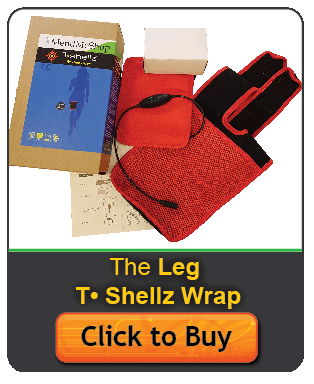 - Use a TShellz Wrap® Once The Swelling is Down - The TShellz Wrap® emits energy intended to increase blood flow in the treatment area. Knowing the body uses blood flow to heal soft tissue, this wrap is designed to maximize your rehabilitation by maintaining a healthy blood flow to soft tissue. Increased blood flow to damaged soft tissue should augment the bodys' own repair process, helping decrease recovery time while reducing re-injury risk. Promoting blood flow and heat to the treatment area will help to minimize the growth of scar tissue, increase tissue flexibility and help reduce onset of atrophy. This is why we recommend TShellz Wrap before undergoing activity - an increase in flexibility should help reduce risk of further injury while also assisting in the battle against atrophy. Heat via the TShellz Wrap® is especially helpful in dealing with chronic tendon & muscle injuries or on-going pain and stiffness from a strained hamstring.
- For reducing discomfort while resting, (or to get some sleep) consider a High Quality Back Pillow and/or Knee Pillow for comfort while sleeping or sitting
- Avoid Over Compensating for your Injury on your "'Healthy' (Non-Injured) Side - Many people will start limping or carrying objects with their opposite arm to compensate for their leg injury. Our bodies can adapt easily to any changes, including a hamstring injury. This quick adaptation could mean that you are already compensating for your injury without even knowing it!
When you compensate for your injury by using your opposite ('healthy') arm, leg, shoulder, knee, foot, etc. - then you are putting more weight and pressure on that side of your body. In many cases, your dominant side was injured (if you're right-handed this would be your right side) so your weaker side is trying to pick up the slack! The pain, stiffness, swelling and inflammation you then get on your 'healthy' side is something referred to as 'over-compensation pain'. Over-compensating for your injury can lead to other injuries and so that's why over compensation should be avoided at all costs OR treated with the same conservative treatment methods as your tendon injury.
- Rehabilitative Stretching under supervision of a PT or doctor. The intent of this is to provide you with increased range of motion, pain relief and strengthening of the surrounding tissue of the joint. Doctors or surgeons typically won't perform a surgery until they feel that their patient has put effort into treating their injury with conservative treatment methods. This may include up to 4 to 6 months of visits to a PT clinic. If you haven't experienced any improvement in your condition during that time then surgery may be considered.
- Stretching - Stretching your joint in PT and at home will help you to regain your range of motion much faster than not stretching at all. Stretching in many ways is key maintaining good Range of Motion (ROM) in your joint, and stretching can be made much easier with use of a TShellz Wrap® before to warm up soft tissue, and a Cold Compress or Ice Pack treatment after to prevent any return of swelling and inflammation.
Some of the options your doctor may recommend include drugs or medications like NSAIDs (non-steroidal anti-inflammatory medication) to manage pain and inflammation. Alternative medications like steroid injections are advised with caution for any type of tendon condition as there is increased risk of rupture of the tendons around the injury following such an injection.
Effective Conservative Treatment Options
are Available
If your doctor has decided that your leg pain can be treated with conservative treatment, you can join our many customers who have had great success in treating themselves with the powerful, conservative treatment products we offer through AidYourHamstring - the Cold Compress or Ice Pack and TShellz Wrap®.
If you need to have surgery, talk to your doctor about using these same products for post-surgery recovery. You'll find them effective for reducing post-surgery inflammation, enhancing range of motion and minimizing the growth of scar tissue in your hamstring.
No one is immune to tendonitis, you can easily reduce your risk of further injury with consistent conservative treatments
Step 1 - Reduce Pain & Swelling with Cold Compression
The 1st step for conservative treatment of your hamstring tendonitis is to reduce the swelling to "open up" the area for more blood flow. Anyone in the health-care business knows that your blood supplies the oxygen and much needed nutrients required to heal any soft tissue injuries. This is why for years doctors, trainers and other medical professional have recommended RICE (Rest, Ice, Compression, Elevation) to treat the pain and swelling of fresh injuries, chronic pain, and after any re-injury.
Cold Compression slows nerve and tissue function - reducing the swelling that blocks blood vessels from doing their job. This is important because once blood vessels are blocked or damaged, they can no longer carry oxygenated blood through the tissue and so it begins to break-down. Without cold compression tissue break-down and damage continues as the tissue doesn't get the oxygen it needs to survive. By limiting the amount of damage done to your tendon, you also limit the amount of healing that needs to occur. This is a very important step to heal tendon injuries faster and with less pain! This is why you need to treat your hamstring pain right after it's hurt, when you notice pain / swelling / inflammation, or directly after a re-injury. Applying a Cold Compress or Ice Pack right away will stop the damage immediately and unblock your blood vessels to let your body's natural blood flow in to start healing the tissue.
Use a Cold Compress or Ice Pack:
- 24 to 72 hours after your initial injury or when you first notice pain and swelling in your hamstring to stop tissue damage, relieve pain, and decrease swelling.
- After exercise, workouts or activity of any kind to prevent re-injury of your hamstring.
- Before and after surgery during rehabilitation to control pre and post-surgery pain and swelling.
- Anytime you feel your hamstring is painful or you're having a flare-up of an old injury.
- Anytime you have swelling, sharp throbbing pain or inflammation in your hamstring.
- Any other situation where you need to draw the pain and inflammation out of your hamstring.
Step 2 - Improve Circulation, Soften Scar Tissue & Prevent Re-Injury with Circulation Boost
After the inflammation in your hamstring has been reduced, providing extra blood flow and strengthening the tissue around your leg is recommended.
Using Circulation Boost (Circulatory Boost), will help with your recovery and heal your tendon more completely. Circulatory Boost increases the amount of blood that flows naturally to your soft tissue to nourish your tendons, improving elasticity and speeding the body's own healing process (via the increase in localized blood flow).
Blood Flow - the natural healing process in your body - needs assistance for such injuries because blood flow is greatly restricted when you are immobile. When treating a bursitis injury or really any type of soft tissue injury (ie. tendinitis, muscles spasm, etc), an effective treatment will increase blood flow to the injury while the joint is immobile. This increase in blood flow will help maximize the body's own capability to heal itself. This is especially true with bursitis, as mobility is almost impossible (too painful) and there is almost no blood flow to the bursa to start with!
There are a LOT of people out there that do not understand how amazing a TShellz Wrap treatment really is. Once initial swelling has reduced by using a Cold Compress or Ice Pack - start short applications with a TShellz Wrap® on the low setting. After a couple treatments we believe you will be astonished with the results.
Our TShellz Wrap® is made from medical-grade material - this should be as important to you as it is to us! Other products that are sold in stores are considered "consumer goods" meaning the material only needs to be as good as a sweater that you wear. Clothing articles like this don't need to meet high standards of production or materials and may include materials that irritate your skin.
Use a TShellz® Circulatory Boost Wrap:
- After swelling and inflammation have been reduced with cold compression.
- Before exercise or workouts to warm up your injury to prevent re-injury.
- Before and after surgery during rehabilitation to warm up your tissues before PT exercising or stretching.
- Anytime you feel the tissue in your leg has stiffened up, is tight and your mobility is reduced causing you more pain.
- Anytime you have sore or aching tissue around your injury.
- Any other situation where you need to boost blood flow and enhance flexibility of tissue in the treatment area.
Continue the healing process by resting your leg. Limit the activities that may be aggravate your tendons. Without proper rest and limitation on activities, being active as if your leg is healthy can lead to re-injury. We spend hours on our leg through simple daily routine, recreational activities, exercise, or participating in athletics. To get back to doing the things you love you need to give your body proper care and attention. Why risk having to limit or give up your favorite weekend activity, your exercise routine, or even your job due to an injury?
Product Advisors are available 9:00 am to 5:00 pm Eastern Standard Time Monday to Friday.
Learn More About Hamstring Injuries & TreatmentsI want to learn more about Hamstring Post-Surgery Recovery I want to learn more about the TShellz® Circulatory Boost Wrap I want to learn more about Ice & Heat: Which Is Better For Treatment? I want to learn more about Stretching for the Hamstring I want to learn more about Soft Tissue Injury Treatments
During your recovery, you will probably have to modify and/or eliminate any activities that cause pain or discomfort at the location of your soft tissue injury until the pain and inflammation settle. Always consult your doctor and/or Physical Therapist before using any of our outstanding products, to make sure they are right for you and your condition. The more diligent you are with your treatment and rehabilitation, the faster you will see successful results!
| 